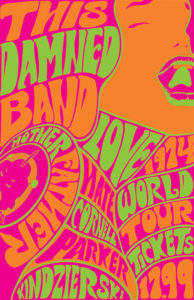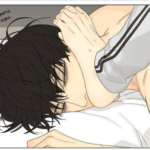
Written by Paul Cornell
Art by Tony Parker
Colours by Lovern Kindzierski
Letters by Michael Heisler
Review by Billy Seguire
 “All that time we were into devil worship, I never thought we were, you know — worshipping the devil” – Justin Parish
“All that time we were into devil worship, I never thought we were, you know — worshipping the devil” – Justin Parish
The 1970s wouldn’t be anything without the debaucherous, indulgent, and dangerous landscape of rock and roll, where satanic imagery and rebellious influence ruled supreme. It was a kingdom that began in backroom bars and was redefined by tragedies like Altamont, the dark side of the coin to Woodstock’s peace and love mantra, as bands became less about music and more about gaudy spectacle. Paul Cornell’s This Damned Band is a distillation of that whole scene. In a pseudo-documentary profiling fictional band Motherfather as they tour in preparation of their latest album, the story serves as dressing to a tale as steeped in devil-worship and the occult as any 70s album cover. It’s a heady trip, ending up as some strange amalgamation of This is Spinal Tap by way of Gimme Shelter meeting The Omen, and that’s by no means a bad thing.
It’s a book that wears its influences lovingly on its flowing ruffled sleeve. Band members are pastiche homages to grand characters like Mick Jagger, Roger Daltrey, and Lemmy. Figures who shaped the 70s by their very presence and make the book enjoyable by their association with the occult spectre hanging over their head. Each member of the band is well-defined, making for an easy readthrough where you understand the band’s dynamics and adds a little different flavour to each member’s perspective. The interviews ensure you get to know everyone sufficiently in This Damned Band’s cast, from bandmates to groupies to managers, and even the documentary crew themselves. While Alex’s indulgences present one of the biggest influences to the plot, my personal favourite band member was Kevin. Instead of having a divine moment with Satan, Kevin claims he was never good at spelling, and enjoys a surrealistic Christmas experience that continues on through multiple interactions. He’s also a character with a true arc, with his relationship to his wife throughout the book forming a serious emotional core to the story, while also being exactly the sort of angle a documentary crew would focus on while profiling a band, even in the midst of all the occult chaos surrounding them.
The documentary style of This Damned Band is used to great effect throughout, with the whole creative team committing fully to the style, whether it’s in interview footage, an acknowledgement of the strictly observational role of the filmmakers, or the aggressive subject getting into the camera’s face, mockumentary tropes are abundant in setting up the veracity of this world. When cameras aren’t around, the comic makes it clear that segments are being rendered as artwork based on the band’s later testimony. It’s a great excuse for the art to get weird and show off skewed perspectives, and comes complete with the surreal imagery you would expect to go hand in hand with this material.
The trippy, drug induced sequences are a definitely a main draw of this book. They don’t present themselves as often as I’d genuinely like, but when they do, it’s a stylistic shift that holds influence over the whole book. Art, colours, and lettering are all affected, displaying total contrast to the naturalistic approach of the rest of the comic. Imagine psychedelic concert posters combined with classic European influences like The Adventures of TinTin, and even manga-like characters, and you’ll begin to have some idea what these sequences are like. When cosmic, demonic characters enter the page, the transition to this style feels right, like they truly are unfathomable and unrepresentable by true reality. It is definitively the best gimmick of the book, and perfectly at home in 1974.
Its an execution so smart, so fitting, I simply found myself wanting more in its continued absence. I was disappointed by how little there was to be had of this excellent gimmick and the way it combines the surreal and occult into an accessible translation. When Clive exclaims “Mere violence? Now? This is meaningless!” it was an eerie echo of my own feelings, as we had already gotten into the fourth issue of a six issue run without any true horror genuinely taking hold, and I had trouble justifying the imagery associated with the series until the overwhelming impact of the final act. For a series supposedly steeped in devil-worshipping rock stars, it wasn’t until issue six that those ideas really came to a head, and I found it far too late into the book to be effective. Issue six at least is everything the series should have been. It is unrelenting in its depiction of blood, violence, and pure inconceivable evil taking reign as hell governs the character’s fates.
Outside of the surreal sequences, some of Parker’s best art is on display during stage scenes, of which both the opening and climactic last issues blowing me away with their depiction of those dated, all-encompassing arena-rock behemoths and the way they seeme to pull off the impossible to give you an incredible experience. The way Parker and Kindzierski collaborate on those overbearing stage lights is a nostalgic trip that gives life to the altered world of the stage. Lovern Kindzierski’s colours specifically are vibrant and perfectly garish, giving the art the lived-in 70s feel it warrants, unafraid to take things to extremes during the subjective sequences shows some bravery. Even Michael Heisler’s letters create an effective medium for evoking the era, adding power to the evil voice of hell to corrupt the world. I’m always interested in breaking the form of any structural elements, and this book provides Heisler the perfect vehicle to do so, truly testing his storytelling chops. Like Parker and Kindzierski, his change of style in the “artist rendered” segments seals the deal in transporting you through drug-fuelled frenzies and consistently enhances the work, with thought put into the work to be done on every page.
I also enjoyed the focus actually given to the groupies as characters rather than objects in the story, even as they were treated as such by the characters. While they’re often sexualized by the characters (one in particular is introduced with the line “hey baby, want some head?”) they’re viewed remarkably objectively by both the creators of the comic and the in-universe film, a set of sensible heads within the sea of rock and roll hedonism. Masculine, satanic violence is consistently circumvented by feminine drive for peace, though the book hammers home how little influence the women have over their own lives, the ones we become most seriously acquainted with show serious agency in the direction of their plots.
The Verdict:
Check It Out. This is a book with creative, organic concepts that fully succeeds in the fantastic execution of its strangest ideas. Reading through, you never get the sensation that This Damned Band is scaling back the cosmic horror to appeal to any common sensibilities, and the comic’s denouement is as bloody and violent as you’d ever hope. I just wish it was… more. That it allowed itself to indulge in these amazing concepts more often before returning back to the ins and outs of 70s band life, and really allowed itself the room to wallow in the occult as advertised. This Damned Band’s version of Satan is horrifyingly grotesque, but the actual satanic figure only realistically shows up about twice in the whole thing. There’s much worth reading until you get to that point, but the story only really happens in the final act. While it’s easier to recommend as a whole rather than single issues of an ongoing series, I still think most of it was a missed opportunity.



